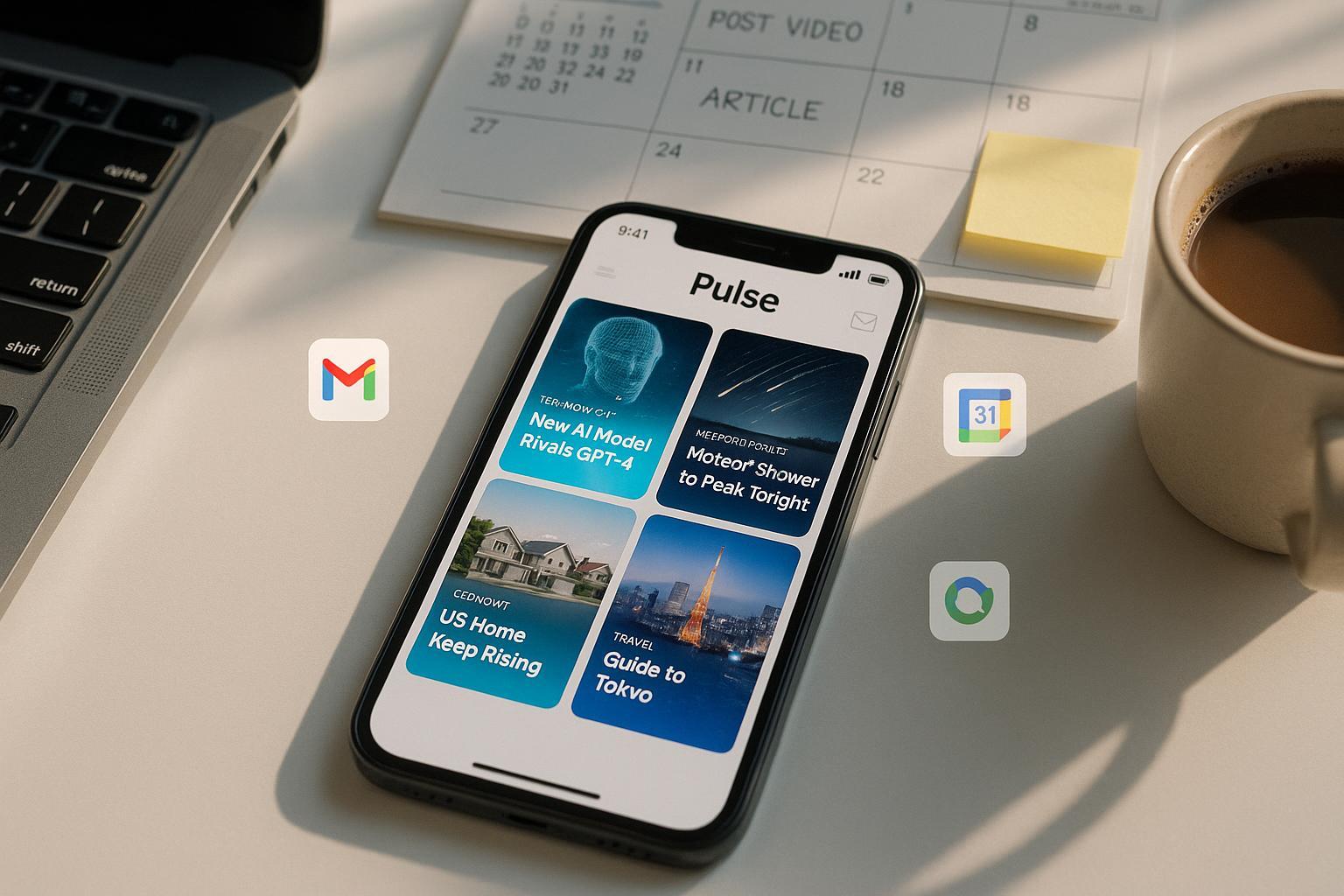ChatGPT Pulse Preview delivers personalized research: A game-changer for content creators (2025)

If you’re a creator or marketer drowning in tabs every morning, ChatGPT’s new Pulse preview may change your routine. Announced on September 25, 2025, Pulse shifts ChatGPT from reactive Q&A to a proactive daily briefing that assembles personalized “visual cards” based on your chats, feedback, and connected apps. According to the OpenAI product page in 2025, this experience is rolling out to Pro users on mobile and lets you curate what it researches with simple feedback controls, as described in OpenAI’s “Introducing ChatGPT Pulse” (2025).
What’s new—and verified
Pulse is designed to run asynchronously and surface a once-a-day set of personalized cards you can scan fast, then tap for deeper context. The availability is limited for now: OpenAI’s help documentation states that Pro users can access Pulse on iOS and Android, and that it’s not available on desktop or web during the preview, per OpenAI Help Center’s “ChatGPT Pulse” (2025). OpenAI’s release notes further confirm the September 2025 preview, with planned expansion after early learnings, noted in OpenAI “ChatGPT Release Notes” (2025).
Beyond the mechanics, media walkthroughs help illustrate behavior. Tom’s Guide describes card-based, scannable feeds that you can expand and query, highlighting how Pulse initiates the day’s conversation and curates the update stream—see Tom’s Guide’s Pulse overview (2025). TechCrunch’s launch coverage shows examples like roundups and itinerary-like suggestions to convey how the briefings can look in practice, as noted in TechCrunch’s launch report (2025).
Why creators should care
Most creators spend too much time on manual research, context switching, and rebuilding momentum across multiple projects. Pulse represents a shift from prompts to proactive support—an AI “morning editorial” assistant that keeps threads moving. The value isn’t that it finds everything; it’s that it reliably surfaces a focused set of items you can triage in minutes and convert into action.
A 15-minute morning triage workflow
-
2–3 minutes: Scan Pulse’s cards, skimming titles and visual cues. Thumbs up items that fit your current priorities; thumbs down what’s off-topic to refine personalization.
-
5 minutes: Open the top one to three cards for detail. Ask quick follow-ups (“summarize the key points,” “give me three angles for a blog post,” “flag sources worth validating”).
-
5 minutes: Move the best items into your production pipeline: idea → brief → outline → draft. Use a repeatable template so every promising card has a clear next step. If you’re new to AI content foundations, this primer on AI-generated content (AIGC) can help set expectations.
-
Final 2 minutes: Archive low-value cards and set reminders for ambiguous leads you’ll revisit later.
From here, standardize two metrics to benchmark ROI: “time-to-brief” (minutes from opening Pulse to a usable brief) and weekly “viable topic leads” (ideas that reach outline stage). Over time, track conversion rate to published posts and average cycle time from brief to publish.
To convert triaged insights into structured drafts and SEO-ready posts, see this step-by-step AI content guide for a practical workflow.
Privacy and control guardrails
- Opt-in connectors: Pulse references connecting apps like Calendar to tailor suggestions; integrations are optional and can be turned on or off in settings, per OpenAI’s product page (2025).
- Curation and feedback: Pulse emphasizes user control—thumbs up/down and direct signals to steer what it researches, also described in OpenAI’s announcement.
- Sensitive work: Keep confidential or high-stakes projects off connected apps. Periodically review Memory/History settings and clear them if needed.
- Safety context: As a preview within ChatGPT, Pulse inherits platform-level safety systems. OpenAI’s broader platform updates in late September 2025 discuss safety routing and parental controls; treat Pulse as operating within those guardrails.
Constraints and a watchlist
- Access: Pro tier, mobile-only (iOS/Android) during preview; web/desktop not available. Monitor release notes for Plus expansion and any desktop rollout.
- Evolving features: Expect UI and behavior to change as OpenAI incorporates feedback.
- Data validation: Use Pulse as a lead generator, not a final source. Verify facts and link to canonical references before publishing.
Turning Pulse briefings into publishable content
Once you’ve triaged your Pulse feed into a shortlist of briefs, move swiftly to outlines and drafts. A blogging platform can help operationalize this step: QuickCreator offers AI-driven drafting and SEO optimization based on SERP analysis, plus block-based editing and one-click WordPress publishing—useful for converting Pulse-surfaced ideas into production without context switching. Disclosure: QuickCreator is our product.
For tighter SEO alignment and topic targeting, creators can pair their workflows with custom GPTs for SEO success to standardize outlines, internal linking, and schema opportunities.
Next steps for creators
- If you’re a Pro user on mobile, enable Pulse and spend a week tracking time-to-brief and viable lead counts.
- Establish a triage template and a weekly review ritual; archive ruthlessly.
- Keep connectors minimal and review privacy settings monthly.
- Monitor OpenAI’s release notes for Plus expansion, desktop/web availability, and any new app integrations.
Updated on 2025-09-30. Availability: Pro users on iOS/Android during preview, not on web/desktop, per OpenAI’s Help Center and release notes.

